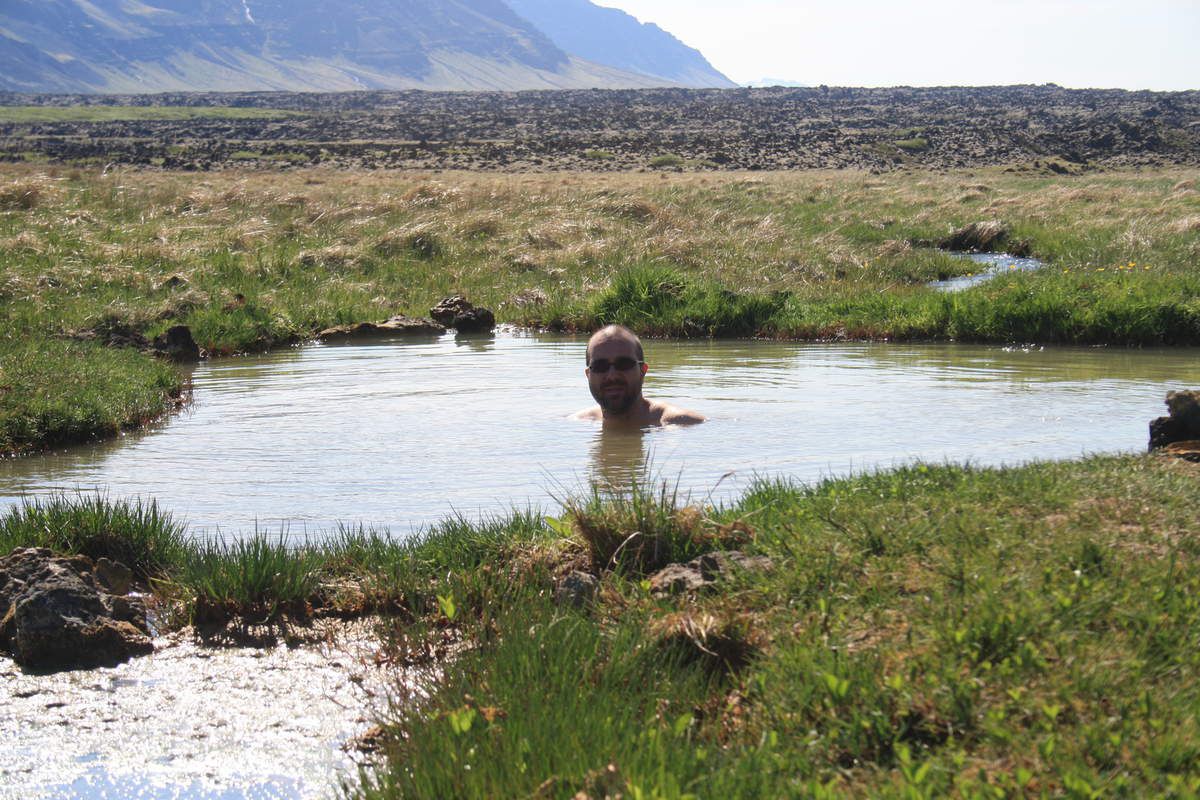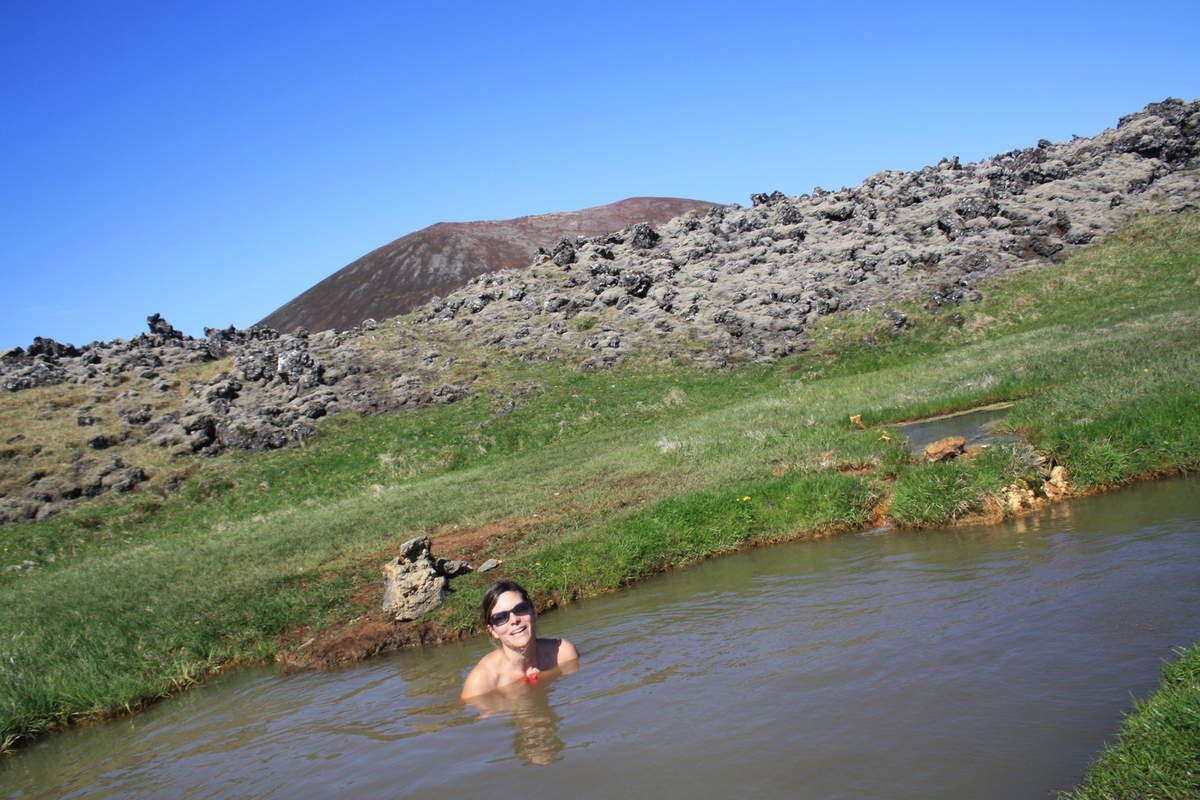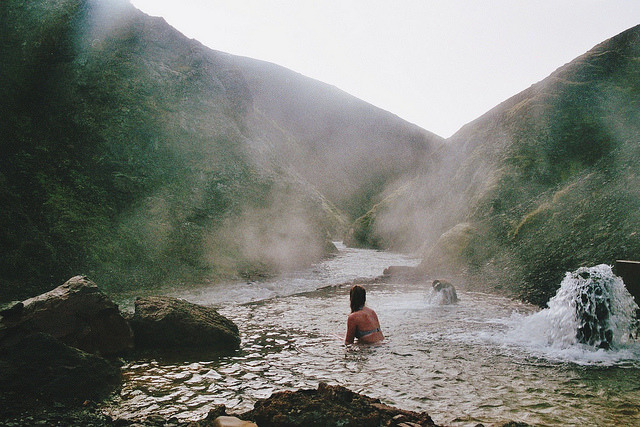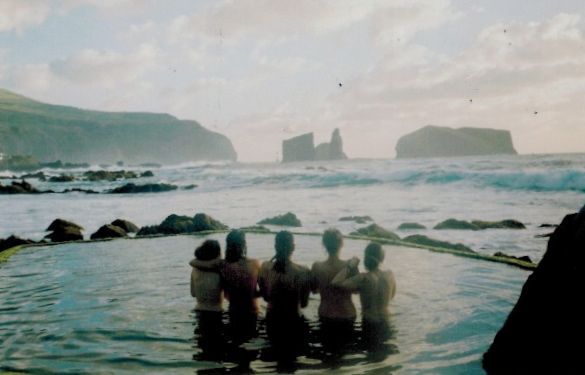Looking westwards
Traversing the Greek island of Milos is not too challenging. A great part of the eastern part of the isle for instance are undulating hills, nothing too serious, mostly ending in cliffs near to some exquisite beaches. And again, it's on one of these beaches where the next geothermal expressions of Milos are to be found.
The beach of Paleochori (Paliochori / Paleohóri) lies on the southeastern side of the island, neatly tucked in under said cliffs, making it a great place to go especially with northern winds. As Milos is here at it's narrowest, it's no surprise that this beach is also one of the islands busier locales: it's easy and well to access from the larger villages on the island. That said, coastal development still is in it's infancy. Then again, as it was still April, the action might well be in revved up during the summer months.
Now let's look at some of the accolades Paleochori beach has attained:
* Tripadvisor rate it as the no. 4 thing to do on the island (hint: the top 3 were all beaches ...).
* Greeka's report (five stars apparently):
'Its crystal-clear waters are a perpetual temptation for swimming and the variety of colours and materials there is really amazing'.
* Cycladia.com:
'As the cyan waters gently lap the golden shore and the splendidly colored cliffs overhang the beach, the striking landscape composes a colorful natural canvas. The stunningly beautiful beach of Paleochori is considered to be one of the most popular beaches of Milos boasting umbrellas, sun beds, restaurants, cafes and wonderful lodgings. It is the perfect place for swimming, nude sunbathing, snorkeling and a variety of water sports'.
* Rough Guide:
'Despite being one of the lower profile Cyclades, most beach connoisseurs rate Milos as the best in this most famous island group. Perhaps that is not so surprising – thanks to its volcanic nature and horseshoe shape, it boasts an impressive seventy-five beaches, yet is barely 20km across.
...
One of the best beaches on the south coast is sandy Paleohóri, gently heated by underground thermal currents and linked to a second strand, hemmed in by colourful cliffs, via a tunnel through the rock'.
* Captain Barefoot:
'Having been to all the beaches mentioned on this website and accessible by the marvellous network of BUSES from Adamas, I would advise all nudism candidates to go to Paleochori.
...
Paliochori beach is widely thought one of the best beaches in Greece'.
* Insight guides:
'Mílos's best beaches are in the southwest "bat wing, starting with Paleohóri - it's far end part-naturist, with stem vents in the sand near which eggs can be fried, and hot water bubbling up in the sea'.
What the above have in common is a focus on how popular and commercial the
beach is (but rest assured, nothing is very overdeveloped) and little elaboration of the geothermal character of the beach.
Let's conclude that Paleochori is worth a visit even without the geothermal features.
Bubbles
In this paragraph we will look into the geothermal phenomena.
To me, the one thing that strikes you as characteristic of Paleochori beach are the sulphur streaks along the cliffs which distinguish it from other (popular) beaches on Milos.
Another distinguishing characteristic is the novelty of the Sirocco restaurant which offers fish / meat dishes that have been prepared under the geothermally heated sands. But possibly only in the summer buzz.
But what about those other geothermal features? Again the internet is not leaving us in the lurch. Let's start with the Greek geothermal keepsake, the Greek-islands.us website:
'The beach of Paleochori has rather high temperatures. Actually, they're
so high that a restaurant close to the beach claims they cook their
dishes on the sand! At some point the temperature of the sand is higher
than 194°F.
...
You should definitely get in. The waters are lukewarm for about 5-6
meters. The beach is usually not crowded because most of the people
prefer the one next to it, with the restaurant'.
* Milos.gr:
'The Beach
of Paliohori is of almost 2 kilometers in total size and it is
extremely popular. It consists of multi-colored pebbles, coarse sand and
fresh crystal clear deep waters. In fact, the beach is composed of
three beaches: the big organized one, the middle one and a small narrow
one surrounded by rocks. In Paliohori you will have the opportunity to
see unique and imposing images, result of the volcanic activity and the
geologic vividness of the region. Apart from the multicolored rocks in
red, pink, yellow and white-grey color, in Paliohori hot springs gush
out. The unbelievable diversity of the existing natural materials and
colors will surely amaze you'.
'One of the volcanic characteristics is the geysers, mostly in the east and south-east, where gases, mostly carbon dioxide, hydrogen sulphide and steam, issue through apertures in the rocks, often causing yellow colouration, the well-known sulphur smell and elevated surface temperature eg. Ag. Kyriaki 102°C, Pyromenes 100°, Paliochori 101°C, Vounalia 54°C, Kastanas 86°C, Adamas 100° C. At points where this occurs under the sea, bubbles of gas are visible on the surface and again the same characteristic smell and elevated temperature. Examples may be seen at Ag. Kyriaki, Paliochori, Kanava and Rivari.
...
These springs are at sea level in Adamas for example, where public baths have been built - the temperature reaching 33,3°C. Further examples are, Alikes (22°C), Kanava (50°C), Paliochori (50°C), Mandrakia (54°C), Adamas Haros (42°C), Provata and Tria Pigadia and elsewhere.
The chief salt present in the waters is sodium chloride, but the sulphates of calcium, magnesium, potassium and ammonia are also to be found, along with carbon dioxide and silicon dioxide. The spa waters are considered to remedy rheumatoid arthritis, gynaecological and dermatological illnesses among others. These areas also exhibit elevated land temperatures'.
'The rocks just behind the beach are also colored in vivid red, due to
their volcanic origin. The volcanic activity is expressed also in the
warm underwater springs which can be felt on some places around the
shore'.
'Paliohori
Temperature: 65-90 C
Composition: sulphur, alipiges (hot springs)'
Hue(s) and cry?
Then we come to milostalgia one of the very limited detailed accounts on a visit to Paleochori and who elaborates such that my own experience might well melt in her shine:
'The restaurant is called Sirocco, the food is solidly good [true], and you get
to eat about 10 feet from the water's edge. The most interesting thing
here is something they called 'volcanic food'. As I've mentioned
before, Milos is a volcanic island with lots of geological oddities.
One of these oddities apparently is that volcanic heat gets quite close
to the surface in some places, including the beach right in front of
Sirocco. So what they've done is create a sort of oven by burying a
metal box in the sand there. And their menu has a 'volcanic food'
section with a few dishes that are cooked in this volcanic oven. I
thought it was a cool concept, but I also doubted it was true. It
sounded like something you would make up for the tourists. But then on
our second trip I had walked a ways down the beach away from the
restaurant and I was standing at the water's edge. As the waves washed
the sand out from under my feet, they sank down a couple of inches and I
had to jerk one of them out fast. It was hot! I stuck my toe down
under the sand again to make sure I hadn't imagined it, but no, the sand
got really hot just a couple inches below the surface. It's a bizarre
thing, but there is some serious volcanic heat coming right up to the
surface in spots of Paleochori. I no longer doubt that Sirocco is
cooking food in the sand in front of their restaurant. (I will however
admit that most of the non-volcanic food we got was better than the
volcanic eggplant dish we tried.)

And on top of the fish, there's another volcanic feature that makes the
snorkeling really impressive. The sea floor at Paleochori is leaking
some kind of gas. Tiny bubbles rise up from the sand throughout the
beach, and some areas are really dense with them. If you listen
underwater you can hear the bubbling, and if the sun is shining through
one of the fields of bubbles, it looks downright surreal.
Unfortunately, I didn't have a waterproof camera, so I didn't get a
picture of it myself, but I did find a picture on the internet that
someone took of the bubbles at Paleochori'.
Streaking
Well, the above leaves me with little need to add anything original, but still I'll give it a try.
We visited here twice, both times with glorious sunny spring weather, it's certainly not a drag to visit this pleasant beach.
As stressed above, the road ends more or less at the Sirocco restaurant which sits to the west of the middle beach.
One can still continue on the road, left (eastwards) for another 200m or so and end at the east part of the central beach. This part (middle section), though the most accessible and it seems most popular, is also the least spectacular.
From Sirocco, head west around or through the rocks (depending on the tide) and you'll end up at (surprise, surprise) the western beach. There's also access to this beach section via stairs coming from a beach bar above the cliffs.
See photo below of west beach section with the stairs in center of beach. Dead ahead are the cliffs with geothermal as evidence of sulphur emissions.
I tried to find the heat sources themselves and was only successful at the westernmost section. The sand there is quite course and the shore slope steepish meaning you are dipping your feet quite deep with every step. At a certain place you felt that the sub-surface temperature a lot higher than the warm sand above it. That ladies and gents, is where you'll hot seepage is taking place.
But alas I found no further evidence, certainly none of warm seawaters!
However on our next visit
we headed eastwards from the middle beach.
Again, once off the main beach,
the cliffs return. As do the spectacular sulphur streaks. Here I swam
out in the sea and witnessed and felt the various sub-marine springs,
quite delicious.
Eastwards
Fuming
There's more to the Paleochori area in geothermal sense, though not always obvious.
Eastwards one can visit an abondoned sulphur mine, already featured earlier on the ENSS blog.
While heading towards Paleochori, note that the area was once the place to develop geothermal power. Alas, state thinking has promoted old school environmental degrading power production near Alikes, pity that.
Then again, the first try was not a success and such being sceptical and reluctant is common. From Spero News (12 Sep. 2009):
'To some in Greece, however, the words geothermal power are synonymous
with the botched project on Milos in the early 1980s, when an attempt by
PPC to develop a small plant there resulted in the release of large
amounts of hydrogen sulphide, a toxic gas responsible for the odour of
rotten eggs and flatulence.
Understandably, many locals on Milos - without whose consent any similar
project there is likely to stall - are deeply opposed to even
discussing the potential of geothermal energy'.
The gases also resulted in trees dying. Nice.
Westwards along the coast are a few more geothermal features. The next beach is that of Agios Kyriaki which is also mentioned to have submarine springs. But none were witnessed on exploration.
Above this beach, to the west, atop the Fyriplaka crater one can experience and discover the emergence of various fumaroles. It's not too strenuous coming from the north, in all it's just a little more than 200m in height. Milos Mining Experience:
'Southernmost point of the at Kalamos: Kaolin outcrops on the outskirts
of the Fyriplaka volcanic cone, where preexisting volcanic rocks have
undergone intense alteration by acidic solutions generated from escaped
hot vapors rich in hydrogen sulfide. At these vents (fumaroles), the
clear, well-formed yellow crystals are deposits of native sulfur formed
by the oxidation of hydrogen sulphide in the atmosphere. The sulfur is
accompanied by a series of relatively rare secondary sulphate minerals
such as melanterite, halotrichite, and alunite, which develop in
clusters and are derived from the chemical alteration of the components
of perlite and other volcanic rocks in the area. Alunite (also known as
alum) has been used as a hemostatic in medicine from ancient times.
Alums and alunogens have also been recorded in the same area.
Sulphate minerals are hydrous minerals and appear pink, white, yellowish
and light green in color. They are extremely fragile and are perceived
as tiny needles, thin encrustations, and compact aggregates.
The
fumaroles, release points of hydrosulfide gas with its
characteristically pungent odor and a temperature reaching 1000 º C, are
most visible when the ambient temperature is low and the condensation
greater. In any case, however, the strong odor of hydrogen sulfide will
be noticed. Beyond the points of stronger fumarole activity which may be
detected over old mine galleries, there are many places with elevated
temperature, easily perceptible to the touch.
To the southwest the
continuity of the volcanic cone and the spread of pyroclastic material,
such as in the Fyriplaka promontory, is visible'.

Once on top one can clamber around to seek the fumaroles
It's a nice walk up, not difficult to find and not only do you get the experience of the fumaroles, there are also excellent views eastwards to the Kyriaki and Paleochori beaches.
Trying something different, there was this tip on Tripadvisor:
'I can also recommend taking a sea kayak trip from Ag. Kyriaki towards
Palaiochori. On the way there are some caves with hot springs as well.
Very impressive!'
'Geothermal activity
continues to this day and can be seen on the western end of the bay
in form of steam vents, hot springs and the only
natural sauna cave in the
world'.
Finally there's the beach of Tsigrado to mention which lies on the other western side of Fyriplaka crater. It's not really very specially, but as you only can access this beach via ropes and ladders, well that's an attraction in itself.















































